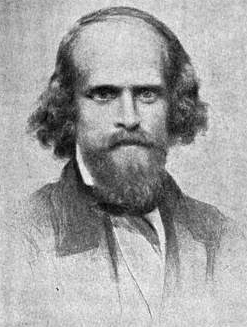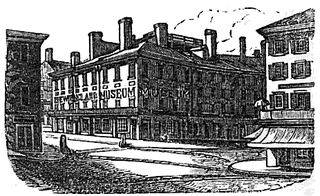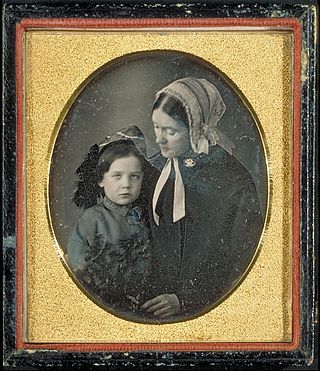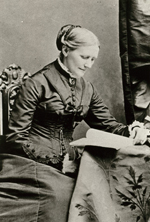
Catherine Greenaway was an English Victorian artist and writer, known for her children's book illustrations. She received her education in graphic design and art between 1858 and 1871 from the Finsbury School of Art, the South Kensington School of Art, the Heatherley School of Art, and the Slade School of Fine Art. She began her career designing for the burgeoning greetings card market, producing Christmas and Valentine's cards. In 1879 wood-block engraver and printer Edmund Evans printed Under the Window, an instant best-seller, which established her reputation. Her collaboration with Evans continued throughout the 1880s and 1890s.
The Freedmen's Aid Society was founded in 1859 during the American Civil War by the American Missionary Association (AMA), a group supported chiefly by the Congregational, Presbyterian and Methodist churches in the North. It organized a supply of teachers from the North and provided housing for them, to set up and teach in schools in the South for freedmen and their children. The AMA founded a total of more than 500 schools and colleges for freedmen in the South after the war, so that freedmen could be educated as teachers, nurses and other professionals.

Bela Lyon Pratt was an American sculptor from Connecticut.

Russell Cheney was an American Impressionist, Post-Impressionist and New England regionalist painter.
Kate Cheney Chappell is an American businesswoman, artist, and manufacturer. She co-founded personal-care product manufacturer Tom's of Maine in 1970 as well as wool clothing manufacturer Ramblers Way in 2010 with her husband Tom Chappell.

Ednah Dow Littlehale Cheney was an American writer, reformer, and philanthropist.

Seth Wells Cheney was an American artist and a pioneer of crayon work in the United States.
Cheney, originally de Cheney, is a toponymic surname of Old French origin, introduced into England by the Normans.

Michael Bryan was an English art historian, art dealer and connoisseur. He was involved in the purchase and resale of the great French Orleans Collection of art, selling it on to a British syndicate, and owned a fashionable art gallery in Savile Row, London. His book, Biographical and Critical Dictionary of Painters and Engravers, first published in 1813–1816, was a standard reference work throughout the 19th century, and was last republished in 1920; however it is now badly outdated.
Ward Cheney was a pioneer manufacturer of silk fabrics.

The New England Museum in Boston, Massachusetts, United States, was established at 76 Court Street by Ethan A. Greenwood, Peter B. Bazin, John Dwight and Samuel Jackson. It featured displays of fine art, natural history specimens, wax figures, and other curiosities. Bands of musicians typically performed there during public hours.
Samuel Smith Kilburn (1831—1903) was an engraver in Boston, Massachusetts, in the 19th century. He trained with Abel Bowen. Kilburn's work appeared in popular periodicals such as Gleason's Pictorial. His business partners included Richard P. Mallory and Henry C. Cross. For many years Kilburn worked at 96 Washington Street in Boston (c.1852-1871); he lived in Newton, Massachusetts. Examples of his work are in the collections of the Boston Athenaeum and the Museum of Fine Arts Boston.

The New England Women's Club of Boston, Massachusetts, was one of the two earliest women's clubs in the United States, having been founded a couple of months after Sorosis in New York City.

Williams & Everett (est.1855) in Boston, Massachusetts, was an art dealership run by Henry Dudley Williams and William Everett. The firm sold original artworks by American and European artists, as well as "photographs and carbon-pictures of eminent persons, noted places, and famous paintings." It also continued the mirror and picture frame business that had been established earlier by the Doggett brothers.

Edward Waldo Emerson was an American physician, writer and lecturer.
The eternal feminine, a concept first introduced by Johann Wolfgang von Goethe in his play Faust (1832), is a transcendental ideality of the feminine or womanly abstracted from the attributes, traits and behaviors of a large number of women and female figures. In Faust, these include historical, fictional, and mythological women, goddesses, and even female personifications of abstract qualities such as wisdom. As an ideal, the eternal feminine has an ethical component, which means that not all women contribute to it. Those who, for example, spread malicious gossip about other women or even just conform slavishly to their society's conventions are by definition non-contributors. Since the eternal feminine appears without explanation only in the last two lines of the play, it is left to the reader to work out which traits and behaviors it involves and which of the various women and female figures in the play contribute them. On these matters Goethe scholars have achieved a certain degree of consensus. The eternal feminine also has societal, cosmic and metaphysical dimensions.

Lucretia Crocker was an American science educator. Crocker founded the Women’s Education Association in 1872.
The Massachusetts Woman Suffrage Association (MWSA) was an American organization devoted to women's suffrage in Massachusetts. It was active from 1870 to 1919.
The Boston Women's Heritage Trail is a series of walking tours in Boston, Massachusetts, leading past sites important to Boston women's history. The tours wind through several neighborhoods, including the Back Bay and Beacon Hill, commemorating women such as Abigail Adams, Amelia Earhart, and Phillis Wheatley. The guidebook includes seven walks and introduces more than 200 Boston women.

Ebenezer Pemberton was an American educator and 2nd Principal of Phillips Academy Andover from 1786 to 1793. Refusing to follow his uncle's wishes to become a clergyman, Pemberton pursued a teaching career that would become his life's work. After graduating from Princeton University, he served terms as principal of a number of schools for early education including Plainfield Academy in Plainfield, Connecticut, Phillips Academy, and his own Pemberton Academy in Billerica, Massachusetts. He founded another school in 1810 in Boston, serving as principal there until poor health forced him to retire.












